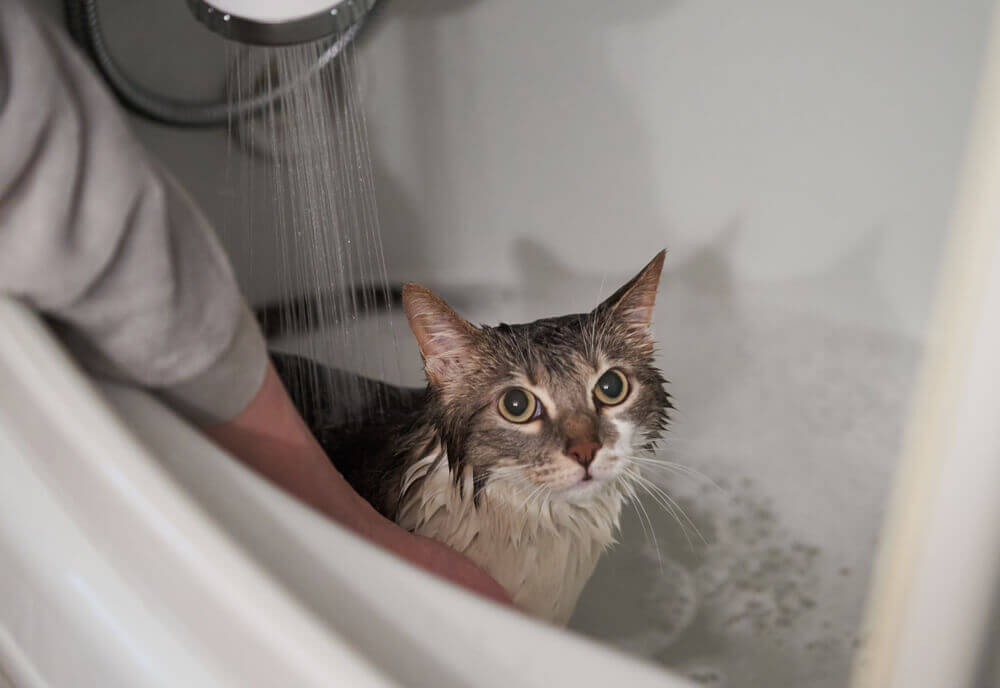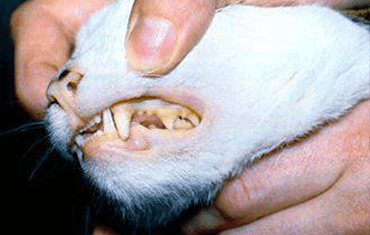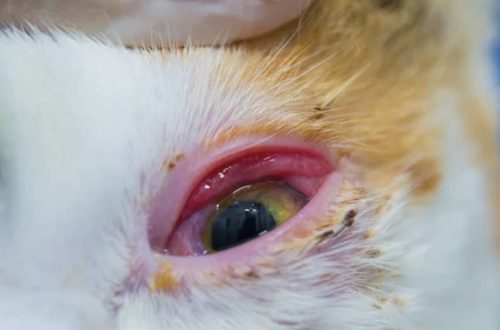
Dermatitis in cats

Contents
Types of dermatitis
Dermatitis can be divided into two groups:
Simple dermatitis. Simple dermatitis in cats develops as a result of skin contact with an irritant. Most cats have fur that can protect the skin from various irritants. However, in practice this is not enough – even cats with thick and dense hair are prone to the appearance of simple dermatitis.
Allergic dermatitis. An allergy is a body reaction caused by an inappropriate, unwanted, and unexpected response of the immune system to exposure to substances that do not normally cause disease or harm. The first sign of an allergic reaction is itching. Quite often, owners fail to notice signs of itching in their cat, as cats are secretive animals and may not show their anxiety for a very long time. Exposure to the body of any allergen can cause allergic dermatitis in a cat, the degree of manifestation of which depends on the physiological characteristics.

Photo of dermatitis in cats

Causes of the disease
The causes of simple dermatitis are various external factors:
- Thermal;
- traumatic;
- parasitic;
- Chemical;
- Infectious.
Thermal dermatitis occurs as a result of exposure to high temperatures on the skin (for example, burns from direct sunlight or a hot stove) or low (frostbite).
Traumatic dermatitis is the result of scratches, bruises and other damage to the skin.
Parasitic dermatitis caused by vital activity on the skin of cats of various insects or mites. The most common parasite is the flea. However, its habitat is not at all the thick hair of your cat, but the environment, that is, rugs, bedding, cracks in the floors, baseboards. In this regard, it is often quite difficult to notice fleas on an animal, they are small in size and prefer to leave their shelter at night. Other parasites that can be found on the skin of an animal are scabies mites. The most common are mites of the genus Demodex (Demodex cati and Demodex gatoi), as well as Notoedres cati and Cheyletiella jasguri. Their dimensions are microscopic and cannot be seen with the naked eye.
Chemical dermatitis I can be the result of contact with the cat’s skin of various highly irritating substances (acids and alkalis).
Infectious dermatitis appear due to reproduction on the skin of various pathogenic flora.
The causes of allergic dermatitis are also different. These include:
- Flea bites (flea allergy dermatitis);
- Inappropriate food (food allergy);
- Components of the environment (atopy).
Flea Allergic Dermatitis occurs in sensitive cats in response to flea bites, its occurrence reaches 50-55% among other types of allergies. Some cats do not notice flea bites at all; they will not have an allergic reaction in response to them. In other animals, inflammatory processes on the skin will be noted. Flea saliva is a protein that, once it enters the cat’s bloodstream, begins to circulate throughout the body and can remain there for up to 2-3 weeks.

alimentary allergy is the rarest of all allergies in animals and occurs only in 5-10% of cases. Most often it can be found in older animals (older than 1-2 years). At first, it may not manifest itself in any way and not cause concern to the owner, since this type of allergy develops rather slowly. The reaction begins to develop only if the amount of the allergen in the blood “exceeds the norm”, which causes an immune response and clinical manifestations in the form of various dermatoses. An allergy can be both to food proteins, and to carbohydrates and various additives. It is a common misconception that the most common allergen in animals is chicken. However, practice shows that beef, pork and fish are in the first place.

Atopic dermatitis in cats, it occurs in response to various environmental components, such as street dust, plant pollen, bed mites, and household chemicals. Its occurrence is in the range of 40-45% among all animals with allergies. In some sources, atopy in cats is mistakenly called neurodermatitis, but only humans are affected by this type of disease. Most often, atopic dermatitis is genetic, that is, hereditary. Identifying an allergen and eliminating it from a cat’s life can be extremely difficult, and often impossible at all. Seasonality can be pronounced (for example, if you are allergic to the pollen of a plant that blooms only in spring) or absent altogether. Therefore, such animals are most often ill chronically, and they require maintenance periodic treatment or lifelong. There is no complete cure for atopic dermatitis.

Symptoms of cat dermatitis
Symptoms of dermatitis in cats are different and depend both on the individual characteristics of the cat and on the cause of the disease. There are some species-specific (that is, only in cats) clinical manifestations of dermatitis. These include the following:

What does dermatitis look like?
- miliary dermatitis. Miliary dermatitis in cats is a set of small pimples or nodules located singly or covering the entire body of the animal. Most often, a crust is visible on the surface of the pimple, then scabs appear. They can be easily felt through the cat’s fur during strokes. The term “miliary” means “millet” – the nodules feel like grains of millet to the touch.
- Seborrheic dermatitis. There are three types of seborrhea in cats. Oily seborrhea is like a dirty, greasy coat mainly in the back. Dry seborrhea is manifested by scales, that is, dandruff on the skin of the animal. Mixed seborrhea combines both features already described.
- Feline eosinophilic granuloma complex. This is a symptom complex that manifests itself in three main forms: eosinophilic granuloma, indolent ulcer and eosinophilic plaques. Eosinophilic granuloma can be located on the skin and at the border of the skin and mucous membranes. By nature, it can be pimples, nodules, sores. Often seen as a swelling under the lower lip, it is usually quite soft and pink to orange-yellow in color. An indolent ulcer is mainly located on the oral mucosa, but can also be on the skin. Characteristic is the defeat of the edge of the upper lip on one or both sides, next to the nasal mirror. Initially, it looks like small ulcers with crusts, which increase in size over time, become well-defined, with a red-brown surface. The surface is concave with raised edges, without treatment, the appearance of foci of necrosis can be observed. Eosinophilic plaques are most commonly found on the abdomen and inner thighs, but can also be found on other parts of the body. Their shape is most often oval, sometimes more elongated. Initially, the lesions are solitary, up to several centimeters in length, but as the disease progresses, they begin to merge and may affect large surfaces of the cat’s body.
Treatment of dermatitis in cats
First of all, it is necessary to establish the most accurate diagnosis, which will allow you to take the disease under control as soon as possible. It is necessary to remember whether the cat could have been injured somewhere, fall or get hurt, in which case the treatment may be limited to washing with antibacterial solutions.
If you see that the animal has stepped on a hot stove, you must immediately apply ice in a thin towel to the burn site, in no case should you pour oil on such a lesion or immediately apply any cream – this will only aggravate the situation.
If the cat has received frostbite, you should gently start warming it up, apply warm heating pads, do not rub the affected areas with your hands or heat it too intensely.
If irritating substances come into contact with the skin of an animal, they should be washed off with water as soon as possible so that the contact is as short as possible and these substances do not have time to penetrate into the deeper layers or be absorbed into the bloodstream.

In any of these cases, you should immediately contact the clinic for further treatment of dermatitis that has arisen in a cat. If the history of the animal does not include all of the above events, additional studies will be required to establish a diagnosis.
Dermatitis in cats caused by scabies mites is successfully treated with antiparasitic drops on the withers, with active ingredients such as selamectin, moxidectin.
If the cause is of an allergic nature, then first you need to try to establish this allergen. There is a certain algorithm for diagnosing allergies. According to him, the doctor will first of all offer to exclude flea dermatitis. To do this, you will need to treat the animal with flea preparations according to a certain scheme, as well as treat the environment with special means (do not forget that fleas do not live on the animal, but indoors). If all skin lesions disappear, it will simply be necessary to leave the prophylactic treatment according to the instructions for the drug, and nothing more will bother the cat. In the absence of any positive dynamics against the background of such treatment, flea dermatitis can be excluded from possible causes. The next step will be the appointment of a special elimination (exclusion) diet, which, by its composition, cannot cause allergic reactions in the animal. It is prescribed for at least 8-10 weeks, and if significant improvements are noted during this time, then it will be necessary to start introducing one familiar component into the diet in order to identify which of them had a reaction earlier. Thus, we will simply eliminate certain foods from the diet, and no other treatment will be needed. If both methods of diagnosis have not brought any success, the animal will be diagnosed with atopic dermatitis. Treatment of this type of allergy is always individual: some cats require high doses and long courses of systemic drugs, and some require topical treatments of damaged areas. Only a doctor can determine how to treat allergic dermatitis in your cat. But in any case, one must be prepared that such an animal is likely to require constant monitoring.
Having figured out how to treat dermatitis in cats, let’s move on to care.
Sick pet care
Caring for a sick pet is no big deal. It is necessary to follow all the recommendations of the attending physician, such as washing with special shampoos, treating the affected skin with antiseptic solutions and ointments, and using drugs inside. It is necessary to come on time for repeated examinations in order to assess the dynamics of treatment, since all animals are individual and even with the same diagnosis, the approach to treatment will differ.

The danger of infection for humans
All types of dermatitis, which we talked about above, are harmless to humans. In rare cases, a person may be bitten by fleas, but then there should be a really significant amount of these parasites in the room, which will already be called a flea infestation and will not be related to flea allergic dermatitis in cats. Also, the Notoedres cati mite can cause the so-called “pseudo scabies” in humans, but cannot cause the actual disease due to the fact that it can only multiply on the skin of cats.

Preventive measures
The best prevention of simple dermatitis is to constantly monitor your pet to prevent burns, frostbite and other possible unpleasant events. It is recommended to carry out regular prophylactic treatment against bites of external parasites with drops on the withers or use special collars. Unfortunately, there is no prevention of allergic conditions, since almost all of them are congenital, and it is simply impossible to predict what your animal will become allergic to. If the allergen is identified, then the main task is to exclude it from the cat’s environment as much as possible and prevent new contacts.

The article is not a call to action!
For a more detailed study of the problem, we recommend contacting a specialist.
Ask the vet
October 6 2020
Updated: February 13, 2021





